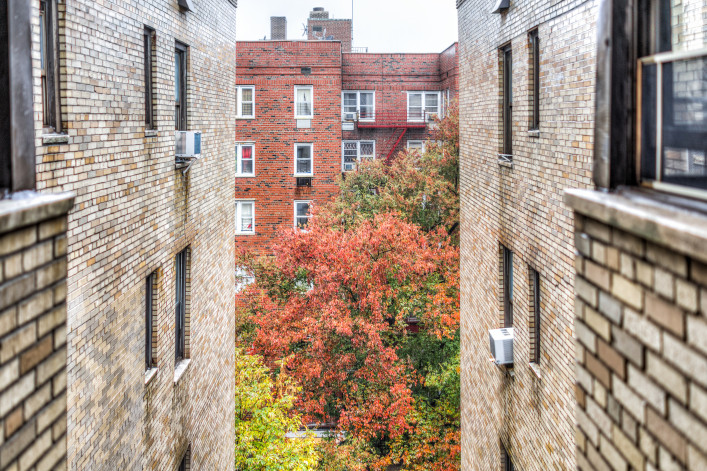Fair deal? How I tracked down my stabilized apartment’s rent history

Stabilized tenants should check their rent history for unusual jumps in the rent, leases for less than a year, and fictitious tenants who never lived in the apartment.
iStock
When I got my recent lease renewal I wasn’t surprised to find a small raise in rent for the upcoming year. I am lucky enough to have a rent-stabilized apartment so the amount my rent is increased each year is never a shock. In fact, some years there have been no raise at all.
On my floor there are two other rent stabilized tenants, both have been living in the building for 35 years. I often wonder how little they pay. While I know there’s no way for me to access their rent records, when a friend had recently mentioned I could access my own, I was intrigued.
It all started with a conversation with my friend, Len, a software engineer and tenants’ rights advocate who lives in Manhattan in a rent-stabilized apartment. We were discussing his ongoing struggles with his own management company (Len requested I use a pseudonym because of his battle).
Len asked me if I had done my research to see if my management company was indeed charging the legal rent.
I recalled that years ago, in my first apartment—a sixth-floor walkup in a Hell’s Kitchen tenement with a very sketchy landlord—a bunch of tenants had contacted a city agency and learned the landlord had been overcharging them on their rent-stabilized units. They got massive reductions as a result. I didn’t know how to do this on my own, but I have always been interested in learning how.
I had done a little investigation, including talking to the long-time doormen. I live in a post-war building and most senior members of staff are familiar with its history. One mentioned that my apartment had very little turnover, and he could clearly recall a woman who had lived there for decades.
Why should you check your rent history?
Turns out, it's a good idea for any stabilized tenant to know how to do a rent history search and there is a number of things to look for: Unusual jumps in the rent, leases for less than a year, and fictitious tenants who never lived in the apartment.
“Many landlords in New York City file false rent registrations, or no registrations at all, that result in rent overcharges and in apartments being illegally removed from rent stabilization,” says David Hershey-Webb, tenant attorney at Himmelstein, McConnell, Gribben, Donoghue & Joseph (FYI, a Brick sponsor).
“If you do find sufficient irregularities in your rent history you may be entitled to a substantial refund, with treble damages, and a reduction in your rent,” he says.
How to start your search
Len told me the first thing to do to learn is to go to the Rent Guidelines Board website, which has lists of buildings with rent stabilized apartments. Keep in mind that just because your building shows up on this list does not mean that your apartment is rent-stabilized.
Another good resource is the Department of Finance’s list of buildings that have a type of tax abatement called a J-51. Landlords that receive J-51 abatement are required to provide rent-stabilized leases to tenants who reside there or move during the duration of this tax benefit and in many cases after the tax benefit expires, Len explains.
How to request your records
Once I understood the basics, I requested my rent records. If you are a current occupant of a unit you may do so. It’s free and simple! One can go to the Division of Housing and Community Renewal, which has offices in Manhattan and Queens, snail mail, email, or call.
Calling takes forever, with hold times of an hour or more! I took my chances and emailed. The form you need to send is called REC-1 and is available here. It’s as sexy as it sounds.
The form is pretty self-explanatory. Len recommended I check the box for “certification,” in case I’d ever need the document in court, and make sure to request 1984-present records.Took me less than a minute to fill out.
It’s worth noting that the information in the form is provided by the building owner. They have to provide tenants a rider in their first lease stating how much they spent to get the rent they are charging. If a tenant challenges an Individual Apartment Increase, as it's called, then the landlord has to provide more detailed documentation.
What I learned
I got my rent records back via mail in a week, and they were fairly straightforward because it turns out my doorman was right; there have only been two previous tenants: One who lived in my unit from 1984 until 2011, when she died (according to the doormen, probably in my actual apartment!) and the woman who took residence for a short time after her.
When the former tenant (Elsie) died, her rent was a paltry $800 and change, but by the time the next tenant (Catherine) took over, it had leaped to $1,400. While there was no explanation or paperwork on record, it could be surmised that the management did a massive gut renovation.
When I moved in nothing had been changed from my predecessor and the unit came with new wood floors, stainless steel appliances and modern light fixtures. So for me everything seemed on the up-and-up. Not much dirt to find and turns out my current rent is the legal amount.
As Len points out, some are not so lucky.
Keep an eye out for red flags
One way to find out if your landlord did renovations would be to search the Department of Building’s website. Search for your building, and check out the “jobs” link. You can compare the increases listed on the rental history with the permits requested for renovations in your building. Most large rent increases that you will see in a rental history occur when the unit is vacant, and presumably the landlord has done renovations in order to justify this increase (like mine).
“A lack of permits would be a big red flag,” Len says. “Another might be that a permit was requested, but the stated cost was low. In order to justify increases in individual units, landlords can undertake Individual Apartment Increases—or IAI’s—whereby the landlord can increase the rent by either 1/60th or 1/40th the amount of the improvements (depending on the number of units in the building). So if you see a rent increase during a vacancy of $1,000 a month, in a large building that would require $60,000 worth of work. If you look in the DOB's website and see a permit that says the cost of materials for the renovation was only $8,000, that’s another big red flag.”
Major Capital Improvements are another way landlords can increase the rent for rent-stabilized tenants. MCI are for certain types of major improvements to the building’s common areas or infrastructure.
“There is a complicated formula involving the total number of rooms (not bedrooms, so living rooms and kitchens count) and an amortization period,” Len explains.
“When you get an MCI approved in your building, for stabilized units the maximum increase is 6 percent per year! That means that if the total requested increase represents an 18 percent increase you will get 6 percent each year for 3 years, in addition to any lease renewal related increases,” Len says.
My own building has had two MCIs since I’ve lived here, and I thought nothing of them. But now that I have this information, if they pass along another, I will certainly be ready.
Change is coming
Albany is about to revisit how MCI’s work, but for now those increases are permanent. If you receive notice that your landlord has filed an MCI, the first thing to do is request an extension of at least 60 days to respond, and then use the REC-1 form to request the “complete file” for the docket. There are many ways to fight MCI’s, but they’re very dependent upon facts in the building.
Len suggests consulting a lawyer once you receive a copy of the complete MCI filing. Likewise, if you find anything amiss in your rent records, you should take action, including calling 311 for information, forming a tenants’ association and consulting an attorney.
Len’s last tip is that you should always get and keep copies of your leases—not just the renewals, but the original lease along with all riders. You are subject to the terms of that lease for the lifetime of your occupancy.
As for me, I’m happy my research unearthed nothing shady about my rent charges. I like my building and its management and am very lucky to have such a great deal—this means I can never move.
You Might Also Like




























